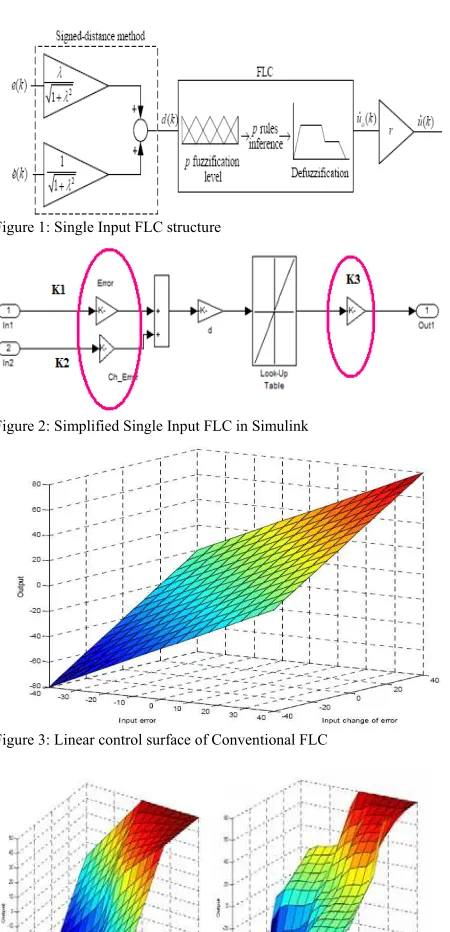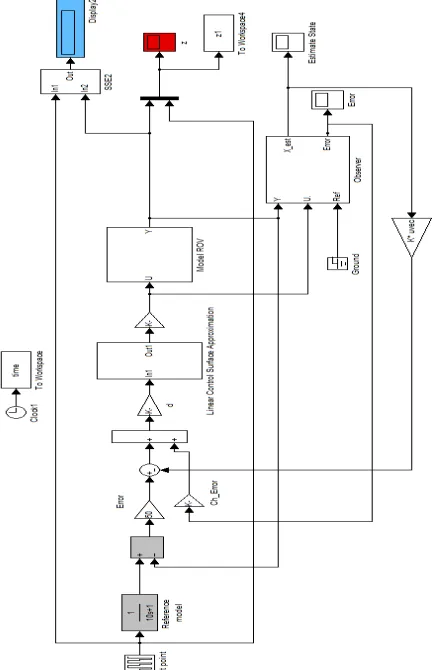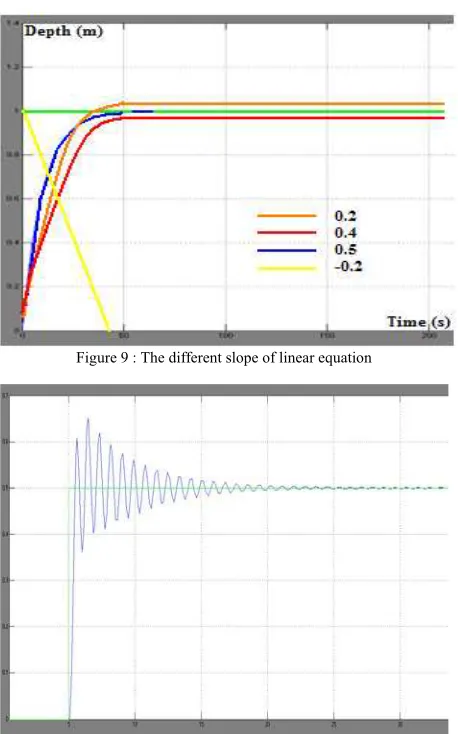Tuning Factor the Single Input Fuzzy Logic Controller to Improve the
Performances of Depth Control for Underwater Remotely Operated Vehicle
Mohd Shahrieel Mohd Aras
1, Anuar Mohamed
Kassim
2, Alias Khamis
3Faculty of Electrical Engineering, UTeM Hang Tuah Jaya, 76100 Durian Tunggal,
Melaka, Malaysia.
1[email protected], 2[email protected], 3[email protected]
Shahrum Shah Abdullah
4, Muhammad Azhar
Abd Aziz
5Department of Electric and Electronic
,
MJIIT-UTM, Jalan Semarak, 54100Kuala Lumpur, Malaysia
4[email protected], 5[email protected]
Abstract - This paper investigates the factor of tuning variable
parameter for Single Input Fuzzy Logic Controller (SIFLC) to improve the performances of depth control for the underwater Remotely Operated Vehicle (ROV). This study and investigates will focus on the number of rules in SIFLC, lookup table, slope of a linear equation, and also model reference to give optimum performances of depth control without overshoot in system response and faster rise time and settling time. The variable parameter for SIFLC is tuned by Particle Swarm Optimization (PSO) algorithm. The investigation focused on the number of rules will be reduced, SIFLC parameter reduced, represented lookup table as a linear control surface method to represent the inference engine of FLC. The investigation on model reference also covered in this paper. The current of model reference will give the best system response for depth control. The slope of linear equation either in positive and negative values and come up from conventional FLC then will simplify into SIFLC. The results obtained the number of rules, the slope of linear equations and model reference will be affecting the results of system performances.
Keywords – Single Input Fuzzy Logic Controller; Linear Control Surface Method; Model Reference; Remotely Operated Vehicle
I. INTRODUCTION
This research inspired from the Conventional Fuzzy Logic Controller (CFLC) Multiple Inputs Single Output (MISO) system will be simplified into Single Input Single Output (SISO) System. Single Input FLC based on Signed Distance Method and piecewise linear control surface method [1-5]. Figure 1 shows the structure of Single Input FLC based on the signed - distance method proposed by [1]. The Single Input FLC in MATLAB Simulink as shown in Figure 2. The two circles in Figure 2 show the variable parameter will be tuned by Particle Swarm Optimization (PSO) algorithm. The studies of PSO can be referred to [6] and [7]. For CFLC, the correlation between the input and output also known as the input and output mapping is normally represented by a three-dimensional plot, known as a control surface (ψ). The control surface is useful for visual assessment and adjustment of the three-dimensional matrix rules and also known as the graphical representation of the combination affects the FLC variables such as the membership functions, overlapping percentage,
fuzzification, inference engine methods and defuzzification operator selections. Previous researchers [8] and [9] have shown that the control property of an FLC is highly dependent on the shape of its control surface. The FLC behaves as a linear controller if control surface ψ reveals a linear surface [9] as depicted in Figure 3. As a result, the controller is also known as a linear Fuzzy Logic Controller. On the other hand, non-linear FLC may come in various control surfaces ψ shape as shown in Figure 4 (a) and Figure 4 (b). Figure 4 is the examples of non-linear control surface. The membership functions, overlapping percentage, fuzzification, inference engine methods and defuzzification operator are variables in general are recognized as tuning parameters. A different set of tuning parameters yields different control surfaces, which results in different control actions by the FLC. Clearly, the optimum tuning of these parameters is the most decisive issues faced by the designers.
For SIFLC, the control surface can be easily reduced to two-dimensional plot that means change into the SISO control surface. This is a natural by a product of the Signed Distance Method (SDM), which has reduced the rules table to a one-dimensional array as derived in the next section [10]. Therefore it is possible to produce an effective control surface for SIFLC without having to look into complex computations coupled with fuzzification, rules inferences and defuzzification processes. The main benefit of the Signed Distance method is the considerable reduction in the number of rules, which in turn minimizes the computation required and execution time. In fact, it is possible for non-linear control surface to be approximated based on piecewise linear. However, before the piecewise linear interpolation is employed, one has to ensure that the process will not dispossess SIFLC from the nonlinear properties of the conventional FLC that have made it a robust controller. The linear equation is simpler to implement in real time system.
Figure 1: Single Input FLC structure
Figure 2: Simplified Single Input FLC in Simulink
Figure 3: Linear control surface of Conventional FLC
(a) (b)
Figure 4: Examples of Non-linear control surface of conventional FLC (a) Control surface with low degree of non-linearity (b) Control surface with high degree of non-linearity.
Due to this, it could be implemented and applied easily to solve various function optimization problems especially for nonlinear models. For this problem, the particle position in PSO can be modelled as Equation 1 for three parameters and Equation 2 for two parameters.
Xi = [K1, K2, K3] (1)
Xi = [K1, K2] (2)
Where x is the particle position, K1, K2, K3 are the parameter values of Single Input Fuzzy Logic Controller proposed by [1] and [10]. SIFLC controller used to control the depth position of the ROV. By using PSO algorithm parameters for SIFLC can be optimized as referred to [5]. The values of third gain are very small and almost constant and assumed to be negligible. The simplified PSO will reduce to two parameters (K1 and K2) will be obtained the most optimum values of SIFLC parameter.
II. NUMBER OF RULES
The study is investigating the number of rules to be reduced. The effect of each of these parameters on the shape of the control surface can be qualitatively determined by trying different combinations of input and output membership functions under specific fuzzification, inference and defuzzification operators. This method of analysis has been proposed by Jantzen [11]. The Fuzzy Toolbox from MATLAB/Simulink used, the resulting control surface of the controller when subjected to different parameter conditions can be readily obtained. First, the rules imposed by the Signed distance method as dictated in Table 1 are considered. Recalling that d is the distance input and u∆ is the output of SIFLC, the seven rules are
Slope of zero diagonal line is equal to “1”, as both membership functions for input in Table 1 are same. The matrix rules used in [1] are 7x7 and will be simplified into a single input as shown in Table 2. The seven input rules will be reduced to five input rules. Based on derivation from [1] and [2], the Look-up Table using equation (3) can be computed. By using equation (3), five input values for corresponding seven diagonal lines in Table 3 are calculated.
2
1
w Ze
d (3)
The derived SISO table is given in Table 2 and Table 3. And also can tabulated in different in slope of linear equations. Next will investigate the slope of the linear control surface.
TABLE 1:EXAMPLE OFRULE TABLE
d L-L L-M L-S LZ LS LM LL
TABLE 2:THE SISO RULE TABLE PROPOSED BY [1]
TABLE 3:THE PROPOSED REDUCED SISO RULE TABLE
d
III. LINEAR CONTROL SURFACE EQUATION
Once the operating conditions to obtain the linear control surface are determined, the output equation can be derived. The aim is to find the relationship between the output equation of the surface and the peak location of input and output membership functions.
Based on Table 3 the data can be plotted as shown in Figure 5, another method for piecewise linear approximation using a linear equation. The linear equation based on look-up table parameter and also can obtain from experiment for open loop test for depth. The result is almost the same. The linear equation is simpler to implement in real time application. The linear equation obtained as in Equation (4)
IV. REFERENCE MODEL
There are many uses for a reference model. One use is to create standards for both the objects that inhabit the model and their relationships to one another. By creating standards, the work of engineers and developers who need to create objects that behave according to the standard is made easier. Software can be written that meets a standard, and developers can copy that software to use it again, or build a software factory that generates that code. When done well, a standard can make use of design patterns that support key qualities of software, such as the ability to extend the software in an inexpensive way [12]. Figure 6 shows the reference model for control design to depth control of the underwater Remotely Operated Vehicle. This reference model acts as input filter. So, the output signal can follow the set point as needed and also to improve the closed-loop response of the set points.
Figure 5: Plotted graph using Look-Up Table for a control surface
Figure 6: Reference Model
V. RESULTS AND DISCUSSION
Figure 7 shows Single Input Fuzzy Logic Controller for Depth Control of Underwater Remotely Operated Vehicle. The Linear Control surface Approximation method will be used. Figure 8 shows the system response of the ROV system.
Figure 8: The system Response of ROV system based on Linear Equation
Figure 9 : The different slope of linear equation
Figure 10: System response without model reference
Figure 11: The system Response of ROV system with model reference
Figure 12: System response with model reference
Figure 9 shows the different slope of linear equation starts from 0.2, 0.4, 0.5, and -0.2. From this figure, the best slope of linear equations for this system is 0.5. The negative slope cannot be used in this system. Based on best value obtain for the slope of linear equations is used to control the variety set point. When the system is running without model reference, the steady state error becomes bigger as shown in Figure 10. Figure 11 shows the system response with model reference where it minimizes the steady state error. Figure 12 shows the system response with model reference where it minimizes the steady state error.
VI. CONCLUSION
the lookup table as a linear control surface method to represent the inference engine of FLC. The model reference gives the performances in depth control better. The reduced of steady state error for the system response with presence of model reference. The slope of linear equation either in positive and negative values obtained gives the best results of system performances.
ACKNOWLEDGMENT
A special appreciation and gratitude to Universiti Teknikal Malaysia Melaka (UTeM) and Universiti Teknologi Malaysia (UTM) especially to the Faculty of Electrical Engineering of both universities for providing the financial as well as moral support to complete this project successfully.
REFERENCES
[1] Kashif ishaque, S.S. Abdullah, S.M. Ayob, Z. Salam, Single Input Fuzzy Logic Controller for Unmanned Underwater Vehicle. In: Journal Intelligence Robot System 2010, 59: pp 87 -100.
[2] M.S.M Aras, H.A. Kasdirin, M.H. Jamaluddin, M F. Basar, Design and Development of an Autonomous Underwater Vehicle (AUV-FKEUTeM), Proceedings of Malaysian Technical Universities Conference on Engineering and Technology (MUCEET2009) Kuantan, Pahang, Malaysia, 2009, pp 1-5.
[3] F.A.Azis, M.S.M. Aras, S.S. Abdullah, Rashid, M.Z.A, M.N. Othman. Problem Identification for Underwater Remotely Operated Vehicle (ROV): A Case Study. Procedia Engineering. 2012; 41: 554-560.
[4] Mohd Shahrieel Mohd Aras, Shahrum Shah Abdullah, Azhan Ab Rahman, Muhammad Azhar Abd Aziz, Thruster Modelling for Underwater Vehicle Using System Identification Method, International Journal of Advanced Robotic Systems, Vol. 10, pp 1 – 12, 2013.
[5] Mohd Shahrieel Mohd Aras, Fadilah binti Abdul Azis,Syed Mohamad Shazali b Syed Abdul Hamid, Fara Ashikin binti Ali, Shahrum Shah b Abdullah, Study of the Effect in the Output Membership Function When Tuning a Fuzzy Logic Controller, 2011 IEEE International Conference on Control System,Computing and Engineering (ICCSCE 2011).
[6] H.I. Jaafar, N.M. Ali, Z. Mohamed, N.A. Selamat, A.M. Kassim, A.F.Z. Abidin, J.J. Jamian, Optimal Performance of a Nonlinear Gantry Crane System via Priority-based Fitness Scheme in Binary PSO Algorithm, Proceedings of 5th International Conference on Mechatronics (ICOM'13),2013, pp 1 -6.
[7] Hazriq Izzuan Jaafar, Z. Mohamed, Amar Faiz Zainal Abidin, Z. Ab Ghani, PSO-Tuned PID Controller for a Nonlinear Gantry, Crane System, IEEE International Conference on Control System, Computing and Engineering, 23 - 25 Nov. 2012, pp 1-5.
[8] Feng, G. A Survey on Analysis and Design of Model-based Fuzzy Control Systems. IEEE Transaction Fuzzy Systems. 2006. 14(5): 676-697.
[9] Farinwata, S.S., Filev, D., and Langari, R. (Eds.). Fuzzy Control: Synthesis and Analysis. Baffins Lane, Chichester: John Wiley & Sons. 2000.
[10] Kashif, Intelligent Control of Diving System of an Underwater Vehicle, Master Thesis, UTM, 2009.
[11] Jantzen, J. Design of Fuzzy Controllers. Technical report. Technical University of Denmark. 1998.


